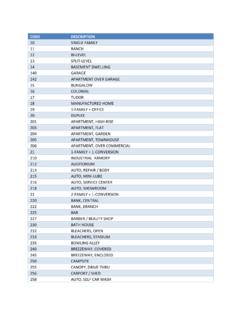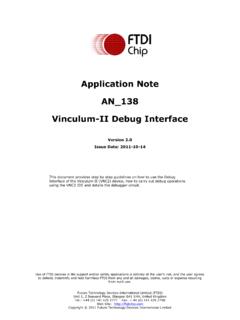Transcription of PIC12F629/675 Data Sheet - Microchip Technology
1 2003 Microchip Technology Inc. DS41190 CPIC12F629/675 data Sheet8-Pin FLASH-Based 8-BitCMOS MicrocontrollersDS41190C - page ii 2003 Microchip Technology contained in this publication regarding deviceapplications and the like is intended through suggestion onlyand may be superseded by updates. It is your responsibility toensure that your application meets with your specifications. Norepresentation or warranty is given and no liability is assumed byMicrochip Technology Incorporated with respect to the accuracyor use of such information, or infringement of patents or otherintellectual property rights arising from such use or of Microchip s products as critical components in lifesupport systems is not authorized except with express writtenapproval by Microchip . No licenses are conveyed, implicitly orotherwise, under any intellectual property Microchip name and logo, the Microchip logo, KEELOQ, MPLAB, PIC, PICmicro, PICSTART, PRO MATE and PowerSmart are registered trademarks of Microchip Technology Incorporated in the and other , microID, MXDEV, MXLAB, PICMASTER, SEEVAL and The Embedded Control Solutions Company are registered trademarks of Microchip Technology Incorporated in the , dsPIC, , ECONOMONITOR, FanSense, FlexROM, fuzzyLAB, In-Circuit Serial Programming, ICSP, ICEPIC, microPort, Migratable Memory, MPASM, MPLIB, MPLINK, MPSIM, PICC, PICkit, PICDEM, , PowerCal, PowerInfo, PowerTool, rfPIC, rfLAB, Select Mode, SmartSensor, SmartShunt, SmartTel and Total Endurance are trademarks of Microchip Technology Incorporated in the and other Quick Turn Programming (SQTP)
2 Is a service mark ofMicrochip Technology Incorporated in the other trademarks mentioned herein are property of theirrespective companies. 2003, Microchip Technology Incorporated, Printed in , All Rights Reserved. Printed on recycled received QS-9000 quality system certification for its worldwide headquarters, design and wafer fabrication facilities in Chandler and Tempe, Arizona in July 1999 and Mountain View, California in March 2002. The Company s quality system processes and procedures are QS-9000 compliant for its PICmicro 8-bit MCUs, KEELOQ code hopping devices, Serial EEPROMs, microperipherals, non-volatile memory and analog products. In addition, Microchip s quality system for the design and manufacture of development systems is ISO 9001 the following details of the code protection feature on Microchip devices: Microchip products meet the specification contained in their particular Microchip data Sheet . Microchip believes that its family of products is one of the most secure families of its kind on the market today, when used in the intended manner and under normal conditions.
3 There are dishonest and possibly illegal methods used to breach the code protection feature. All of these methods, to our knowledge, require using the Microchip products in a manner outside the operating specifications contained in Microchip 's data Sheets. Most likely, the person doing so is engaged in theft of intellectual property. Microchip is willing to work with the customer who is concerned about the integrity of their code. Neither Microchip nor any other semiconductor manufacturer can guarantee the security of their code. Code protection does not mean that we are guaranteeing the product as unbreakable. Code protection is constantly evolving. We at Microchip are committed to continuously improving the code protection features of ourproducts. Attempts to break Microchip s code protection feature may be a violation of the Digital Millennium Copyright Act. If such actsallow unauthorized access to your software or other copyrighted work, you may have a right to sue for relief under that Act.
4 2003 Microchip Technology 1 PIC12F629/675 High Performance RISC CPU: Only 35 instructions to learn- All single cycle instructions except branches Operating speed:- DC - 20 MHz oscillator/clock input- DC - 200 ns instruction cycle Interrupt capability 8-level deep hardware stack Direct, Indirect, and Relative Addressing modesSpecial Microcontroller Features: Internal and external oscillator options- Precision Internal 4 MHz oscillator factory calibrated to 1%- External Oscillator support for crystals and resonators-5 s wake-up from SLEEP, , typical Power saving SLEEP mode Wide operating voltage range - to Industrial and Extended temperature range Low power Power-on Reset (POR) Power-up Timer (PWRT) and Oscillator Start-up Timer (OST) Brown-out Detect (BOD) Watchdog Timer (WDT) with independent oscillator for reliable operation Multiplexed MCLR/Input-pin Interrupt-on-pin change Individual programmable weak pull-ups Programmable code protection High Endurance FLASH/EEPROM Cell- 100,000 write FLASH endurance- 1,000,000 write EEPROM endurance- FLASH/ data EEPROM Retention: > 40 yearsLow Power Features: Standby Current:- 1 nA @ , typical Operating A @ 32 kHz, , typical-100 A @ 1 MHz, , typical Watchdog Timer Current- 300 nA @ , typical Timer1 oscillator current.
5 -4 A @ 32 kHz, , typicalPeripheral Features: 6 I/O pins with individual direction control High current sink/source for direct LED drive Analog comparator module with:- One analog comparator- Programmable on-chip comparator voltage reference (CVREF) module- Programmable input multiplexing from device inputs- Comparator output is externally accessible Analog-to-Digital Converter module (PIC12F675):- 10-bit resolution- Programmable 4-channel input- Voltage reference input Timer0: 8-bit timer/counter with 8-bit programmable prescaler Enhanced Timer1:- 16-bit timer/counter with prescaler- External Gate Input mode- Option to use OSC1 and OSC2 in LP mode as Timer1 oscillator, if INTOSC mode selected In-Circuit Serial ProgrammingTM (ICSPTM) via two pins* 8-bit, 8-pin devices protected by Microchip s Low Pin Count Patent: Patent No. 5,847,450. Additional andforeign patents and applications may be issued or MemoryData MemoryI/O10-bit A/D (ch)ComparatorsTimers8/16-bitFLASH(words ) SRAM (bytes)EEPROM (bytes)PIC12F6291024641286 11/1 PIC12F6751024641286411/18-Pin FLASH-Based 8-Bit CMOS MicrocontrollerPIC12F629/675DS41190C-pag e 2 2003 Microchip Technology DiagramsVSSVDDGP5/T1 CKI/OSC1/CLKINGP4/AN3/T1G/OSC2/CLKOUTGP3 /MCLR/VPPGP0/AN0/CIN+/ICSPDATGP1/AN1/CIN -/VREF/ICSPCLKGP2/AN2/T0 CKI/INT/COUT12345678 PIC12F675 VSSVDDGP5/T1 CKI/OSC1/CLKINGP4/T1G/OSC2/CLKOUTGP3/MCL R/VPPGP0/CIN+/ICSPDATGP1/CIN-/ICSPCLKGP2 /T0 CKI/INT/COUT12345678 PIC12F6298-pin PDIP, SOIC, DFN-S 2003 Microchip Technology 3 PIC12F629/675 Table of Device Memory GPIO Port.
6 Timer0 Timer1 Module with Gate Control .. Comparator Module .. Analog-to-Digital Converter (A/D) Module (PIC12F675 only) .. data EEPROM Memory .. Special Features of the CPU .. Instruction Set Summary .. Development Support .. Electrical Specifications .. DC and AC Characteristics Graphs and Tables .. Packaging Information .. 115 Appendix A: data Sheet Revision History .. 121 Appendix B: Device Differences .. 121 Appendix C: Device Migrations .. 122 Appendix D: Migrating from other PICmicro Devices ..122 Index .. 123On-Line Support .. 127 Systems Information and Upgrade Hot Line .. 127 Reader Response .. 128 Product Identification System .. 129TO OUR VALUED CUSTOMERSIt is our intention to provide our valued customers with the best documentation possible to ensure successful use of your Microchipproducts. To this end, we will continue to improve our publications to better suit your needs. Our publications will be refined andenhanced as new volumes and updates are introduced.
7 If you have any questions or comments regarding this publication, please contact the Marketing Communications Department viaE-mail at or fax the Reader Response Form in the back of this data Sheet to (480) welcome your Current data SheetTo obtain the most up-to-date version of this data Sheet , please register at our Worldwide Web site at: can determine the version of a data Sheet by examining its literature number found on the bottom outside corner of any last character of the literature number is the version number, ( , DS30000A is version A of document DS30000).ErrataAn errata Sheet , describing minor operational differences from the data Sheet and recommended workarounds, may exist for currentdevices. As device/documentation issues become known to us, we will publish an errata Sheet . The errata will specify the revisionof silicon and revision of document to which it determine if an errata Sheet exists for a particular device, please check with one of the following: Microchip s Worldwide Web site; Your local Microchip sales office (see last page) The Microchip Corporate Literature Center; FAX: (480) 792-7277 When contacting a sales office or the literature center, please specify which device, revision of silicon and data Sheet (include liter-ature number) you are Notification SystemRegister on our web site at to receive the most current information on all of our 4 2003 Microchip Technology : 2003 Microchip Technology 5 PIC12F629 DEVICE OVERVIEWThis document contains device specific information forthe PIC12F629/675 .
8 Additional information may befound in the PICmicroTM Mid-Range Reference Manual(DS33023), which may be obtained from your localMicrochip Sales Representative or downloaded fromthe Microchip web site. The Reference Manual shouldbe considered a complementary document to this DataSheet, and is highly recommended reading for a betterunderstanding of the device architecture and operationof the peripheral PIC12F629 and PIC12F675 devices are coveredby this data Sheet . They are identical, except thePIC12F675 has a 10-bit A/D converter. They come in8-pin PDIP, SOIC, and MLF-S packages. Figure 1-1shows a block diagram of the PIC12F629/675devices. Table 1-1 shows the Pinout 1-1: PIC12F629/675 BLOCK DIAGRAMFLASHP rogramMemory1K x 1413 data Bus814 ProgramBusInstruction RegProgram Counter8-Level Stack(13-bit)RAMFileRegisters64 x 8 Direct Addr7 Addr(1)9 Addr MUXI ndirectAddrFSR RegSTATUS RegMUXALUW RegPower-upTimerOscillatorStart-up TimerPower-onResetWatchdogTimerInstructi onDecode &ControlOSC1/CLKINOSC2/CLKOUTVDD, VSS88 Brown-outDetect83 TimingGenerationGP5/T1 CKI/OSC1/CLKINI nternal4 MHzRAMGP4/AN3/T1G/OSC2/CLKOUTGP3/MCLR/VP PGP2/AN2/T0 CKI/INT/COUTGP1/AN1/CIN-/VREFGP0/AN0/CIN +OscillatorNote 1: Higher order bits are from STATUS bytesEEDATAEEADDRC omparatorAnalog to Digital Converter (PIC12F675 only)AN0AN1AN2AN3 CIN-CIN+COUTT0 CKIT1 CKIVREFand referenceT1G8 PIC12F629/675DS41190C-page 6 2003 Microchip Technology 1-1.
9 PIC12F629/675 PINOUT DESCRIPTIONNameFunctionInputTypeOutputTy peDescriptionGP0/AN0/CIN+/ICSPDATGP0 TTLCMOSBi-directional I/O w/ programmable pull-up and interrupt-on-changeAN0 ANA/D Channel 0 inputCIN+ANComparator inputICSPDATTTLCMOSS erial programming I/OGP1/AN1/CIN-/VREF/ICSPCLKGP1 TTLCMOSBi-directional I/O w/ programmable pull-up and interrupt-on-changeAN1 ANA/D Channel 1 inputCIN-ANComparator inputVREFANE xternal voltage referenceICSPCLKSTS erial programming clockGP2/AN2/T0 CKI/INT/COUTGP2 STCMOSBi-directional I/O w/ programmable pull-up and interrupt-on-changeAN2 ANA/D Channel 2 inputT0 CKISTTMR0 clock inputINTSTE xternal interruptCOUTCMOSC omparator outputGP3/MCLR/VPPGP3 TTLI nput port w/ interrupt-on-changeMCLRSTM aster ClearVPPHVP rogramming voltageGP4/AN3/T1G/OSC2/CLKOUTGP4 TTLCMOSBi-directional I/O w/ programmable pull-up and interrupt-on-changeAN3 ANA/D Channel 3 inputT1 GSTTMR1 gateOSC2 XTALC rystal/resonatorCLKOUTCMOSFOSC/4 outputGP5/T1 CKI/OSC1/CLKINGP5 TTLCMOSBi-directional I/O w/ programmable pull-up and interrupt-on-changeT1 CKISTTMR1 clockOSC1 XTALC rystal/resonatorCLKINSTE xternal clock input/RC oscillator connectionVSSVSSP owerGround referenceVDDVDDP owerPositive supplyLegend: Shade = PIC12F675 only TTL = TTL input buffer, ST = Schmitt Trigger input buffer 2003 Microchip Technology 7 PIC12F629 MEMORY Program Memory OrganizationThe PIC12F629/675 devices have a 13-bit programcounter capable of addressing an 8K x 14 programmemory space.
10 Only the first 1K x 14 (0000h - 03 FFh)for the PIC12F629/675 devices is physically imple-mented. Accessing a location above these boundarieswill cause a wrap around within the first 1K x 14 RESET vector is at 0000h and the interrupt vectoris at 0004h (see Figure 2-1).FIGURE 2-1:PROGRAM MEMORY MAP AND STACK FOR THE PIC12F629/675 data Memory OrganizationThe data memory (see Figure 2-2) is partitioned intotwo banks, which contain the General Purpose regis-ters and the Special Function registers. The SpecialFunction registers are located in the first 32 locations ofeach bank. Register locations 20h-5Fh are GeneralPurpose registers, implemented as static RAM and aremapped across both banks. All other RAM isunimplemented and returns 0 when read. RP0(STATUS<5>) is the bank select bit. RP0 = 0 Bank 0 is selected RP0 = 1 Bank 1 is PURPOSE REGISTER FILEThe register file is organized as 64 x 8 in thePIC12F629/675 devices. Each register is accessed,either directly or indirectly, through the File SelectRegister FSR (see Section ).















